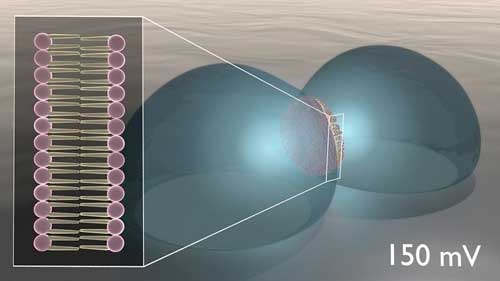| Jul 20, 2020 | |
Oil and water almost mix in novel neuromorphic computing components(Nanowerk News) Researchers developed a novel memory storage device that uses soft biomaterials. These are artificial materials designed to work like natural biological materials. The memory storage device mimics synapses, the connections between nerve cells (Nature Communications, "Dynamical nonlinear memory capacitance in biomimetic membranes"). |
|
| The device consists of two layers of fatty organic compounds called lipids. The lipid layers form at an oil-water interface to create a soft membrane. When scientists apply an electric charge to the membrane, the membrane changes shape in ways that can store energy and filter biological and chemical data. | |
 |
|
| Researchers demonstrated the first example of a lipid-based “memcapacitor,” an energy storage device with memory that advances brain-like, synaptic information processing in neuromorphic computing. (Image: Oak Ridge National Laboratory) | |
| The novel membrane speeds the development of hardware to support neuromorphic computing networks. These are computing systems that draw their design from nervous systems found in nature. Systems designed with bio-circuitry open new pathways for artificial intelligence. They are especially promising for real time sensing applications. | |
| They are also promising for distributed “edge” computing, which places computer storage and processing resources close to the location where they are needed to produce flexible, scalable networks with low energy costs. | |
| Neuromorphic computing systems mimic the brain’s synaptic circuitry. The technology offers increased efficiency and interconnectivity. It also offers unique potential for computing nondigital or sensory information using architectures based on biology. | |
| Neuromorphic systems are gaining interest for use in wearable or embedded technologies that can compute on the fly, without connection to a cloud, by leveraging the highly specialized sensing and detection capabilities found in biological molecules. | |
| To advance these neuromorphic computers, scientists must develop novel materials and computing elements that differ from the solid-state electronic devices used in traditional digital computers. | |
| Neuromorphic computers are based on “memelements,” components that combine both processing and memory in a single location to mimic the way neurons and synapses evaluate, learn, and communicate sensory information. | |
| Researchers are developing novel biomaterials to support memelements. They have previously demonstrated a memristor, a component that evaluates information to determine if the signal is strong enough to propagate. | |
| This new research goes a step further by demonstrating a memcapacitor, a signal processing device that can also store energy, enabling greater complexity in neuromorphic networks. |
| Source: U.S. Department of Energy, Office of Science | |
|
Subscribe to a free copy of one of our daily Nanowerk Newsletter Email Digests with a compilation of all of the day's news. |
